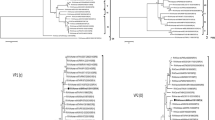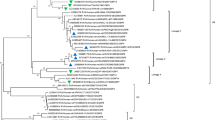Abstract
Equine group A rotavirus (RVA) G3P[12] and G14P[12] strains cause gastroenteritis in foals worldwide. Both of these strains have been co-circulating in Japan since G14P[12] strains emerged in the late 1990s. Although it is important to comprehensively understand the evolution of RVA strains, whole-genome sequence data on recent equine RVA strains in Japan are lacking. Therefore, in this study, whole-genome analysis of 23 equine RVA isolates from the late 1990s and 2009-2010 and the vaccine strain RVA/Horse-tc/JPN/HO-5/1982/G3P[12] (HO-5) was performed. The G3 strains, including strain HO-5, shared a G3-P[12]-I6-R2-C2-M3-A10-N2-T3-E2-H7 genotype constellation, and all of their 11 gene segments were highly conserved, regardless of the year of isolation. G14 strains also exhibited an identical genotype constellation (G14-P[12]-I2-R2-C2-M3-A10-N2-T3-E2-H7), but, phylogenetically, segregated into two lineages within the VP7-G14 and NSP4-E2 genotypes. G14 strains were closely related to G3 strains in their VP4, VP1-3, NSP1-3 and NSP5 gene segments. Interestingly, the NSP4 gene of all G3 and G14 strains isolated in the late 1990s branched into a bovine-RVA-like NSP4 gene cluster. These results indicate that, apart from VP7, VP6, and NSP4 genes, the Japanese equine RVA strains share a highly conserved genetic backbone, and that strains possessing a bovine-RVA-like NSP4 gene were predominant in the late 1990s in Japan.



Similar content being viewed by others
References
Browning GF, Chalmers RM, Snodgrass DR, Batt RM, Hart CA, Ormarod SE, Leadon D, Stoneham SJ, Rossdale PD (1991) The prevalence of enteric pathogens in diarrhoeic thoroughbred foals in Britain and Ireland. Equine Vet J 23:405–409
Frederick J, Giguere S, Sanchez LC (2009) Infectious agents detected in the feces of diarrheic foals: a retrospective study of 233 cases (2003-2008). J Vet Intern Med 23:1254–1260
Slovis NM, Elam J, Estrada M, Leutenegger CM (2014) Infectious agents associated with diarrhoea in neonatal foals in central Kentucky: a comprehensive molecular study. Equine Vet J 46:311–316
Estes MK, Greenberg HB (2013) Rotaviruses. In: Knipe DM, Howley PM (eds) Fields virology. Lippincott Williams & Wilkins, Philadelphia, pp 1347–1401
Estes MK, Greenberg HB (2013) Rotaviruses. In: Knipe DM, Howley PM (eds) Fields virology. Lippincott Williams & Wilkins, Philadelphia, pp 1347–1401
Matthijnssens J, Ciarlet M, McDonald SM, Attoui H, Banyai K, Brister JR, Buesa J, Esona MD, Estes MK, Gentsch JR, Iturriza-Gomara M, Johne R, Kirkwood CD, Martella V, Mertens PP, Nakagomi O, Parreno V, Rahman M, Ruggeri FM, Saif LJ, Santos N, Steyer A, Taniguchi K, Patton JT, Desselberger U, Van Ranst M (2011) Uniformity of rotavirus strain nomenclature proposed by the Rotavirus Classification Working Group (RCWG). Arch Virol 156:1397–1413
Trojnar E, Sachsenröder J, Twardziok S, Reetz J, Otto PH, Johne R (2013) Identification of an avian group A rotavirus containing a novel VP4 gene with a close relationship to those of mammalian rotaviruses. J Gen Virol 94:136–142
Collins PJ, Cullinane A, Martella V, O’Shea H (2008) Molecular characterization of equine rotavirus in Ireland. J Clin Microbiol 46:3346–3354
Elschner M, Schrader C, Hotzel H, Prudlo J, Sachse K, Eichhorn W, Herbst W, Otto P (2005) Isolation and molecular characterisation of equine rotaviruses from Germany. Vet Microbiol 105:123–129
Garaicoechea L, Mino S, Ciarlet M, Fernandez F, Barrandeguy M, Parreno V (2011) Molecular characterization of equine rotaviruses circulating in Argentinean foals during a 17-year surveillance period (1992-2008). Vet Microbiol 148:150–160
Monini M, Biasin A, Valentini S, Cattoli G, Ruggeri FM (2011) Recurrent rotavirus diarrhoea outbreaks in a stud farm, in Italy. Vet Microbiol 149:248–253
Nemoto M, Tsunemitsu H, Imagawa H, Hata H, Higuchi T, Sato S, Orita Y, Sugita S, Bannai H, Tsujimura K, Yamanaka T, Kondo T, Matsumura T (2011) Molecular characterization and analysis of equine rotavirus circulating in Japan from 2003 to 2008. Vet Microbiol 152:67–73
Ntafis V, Fragkiadaki E, Xylouri E, Omirou A, Lavazza A, Martella V (2010) Rotavirus-associated diarrhoea in foals in Greece. Vet Microbiol 144:461–465
Tsunemitsu H, Imagawa H, Togo M, Shouji T, Kawashima K, Horino R, Imai K, Nishimori T, Takagi M, Higuchi T (2001) Predominance of G3B and G14 equine group A rotaviruses of a single VP4 serotype in Japan. Arch Virol 146:1949–1962
Ghosh S, Shintani T, Kobayashi N (2012) Evidence for the porcine origin of equine rotavirus strain H-1. Vet Microbiol 158:410–414
Ghosh S, Taniguchi K, Aida S, Ganesh B, Kobayashi N (2013) Whole genomic analyses of equine group A rotaviruses from Japan: evidence for bovine-to-equine interspecies transmission and reassortment events. Vet Microbiol 166:475–48515
Matthijnssens J, Mino S, Papp H, Potgieter C, Novo L, Heylen E, Zeller M, Garaicoechea L, Badaracco A, Lengyel G, Kisfali P, Cullinane A, Collins PJ, Ciarlet M, O’Shea H, Parreno V, Banyai K, Barrandeguy M, Van Ranst M (2012) Complete molecular genome analyses of equine rotavirus A strains from different continents reveal several novel genotypes and a largely conserved genotype constellation. J Gen Virol 93:866–875
Mino S, Matthijnssens J, Badaracco A, Garaicoechea L, Zeller M, Heylen E, Van Ranst M, Barrandeguy M, Parreno V (2013) Equine G3P[3] rotavirus strain E3198 related to simian RRV and feline/canine-like rotaviruses based on complete genome analyses. Vet Microbiol 161:239–246
El-Attar L, Dhaliwal W, Howard CR, Bridger JC (2001) Rotavirus cross-species pathogenicity: molecular characterization of a bovine rotavirus pathogenic for pigs. Virology 291:172–182
Imagawa H, Tanaka T, Sekiguchi K, Fukunaga Y, Anzai T, Minamoto N, Kamada M (1993) Electropherotypes, serotypes, and subgroups of equine rotaviruses isolated in Japan. Arch Virol 131:169–176
Imagawa H, Kato T, Tsunemitsu H, Tanaka H, Sato S, Higuchi T (2005) Field study of inactivated equine rotavirus vaccine. J Equine Sci 16:35–44
Nemoto M, Tsunemitsu H, Murase H, Nambo Y, Sato S, Orita Y, Imagawa H, Bannai H, Tsujimura K, Yamanaka T, Matsumura T, Kondo T (2012) Antibody response in vaccinated pregnant mares to recent G3BP[12] and G14P[12] equine rotaviruses. Acta Vet Scand 54:63
Katayama K, Kurihara C, Fukushi S, Hoshino FB, Ishikawa K, Nagai H, Ando T, Oya A (1995) Characterization of the hog cholera virus 5′ terminus. Virus Genes 10:185–187
Thompson JD, Higgins DG, Gibson TJ (1994) CLUSTAL W: improving the sensitivity of progressive multiple sequence alignment through sequence weighting, position-specific gap penalties and weight matrix choice. Nucleic Acids Res 22:4673–4680
Kimura M (1980) A simple method for estimating evolutionary rates of base substitutions through comparative studies of nucleotide sequences. J Mol Evol 16:111–120
Saitou N, Nei M (1987) The neighbor-joining method: a new method for reconstructing phylogenetic trees. Mol Biol Evol 4:406–425
Tamura K, Peterson D, Peterson N, Stecher G, Nei M, Kumar S (2011) MEGA5: molecular evolutionary genetics analysis using maximum likelihood, evolutionary distance, and maximum parsimony methods. Mol Biol Evol 28:2731–2739
Felsenstein J (1985) Confidence limits on phylogenies: an approach using the bootstrap. Evolution 39:783–791
Maes P, Matthijnssens J, Rahman M, Van Ranst M (2009) RotaC: a web-based tool for the complete genome classification of group A rotaviruses. BMC Microbiol 9:238
Minami-Fukuda F, Nagai M, Takai H, Murakami T, Ozawa T, Tsuchiaka S, Okazaki S, Katayama Y, Oba M, Nishiura N, Sassa Y, Omatsu T, Furuya T, Koyama S, Shirai J, Tsunemitsu H, Fujii Y, Katayama K, Mizutani T (2013) Detection of bovine group a rotavirus using rapid antigen detection kits, rt-PCR and next-generation DNA sequencing. J Vet Med Sci 75:1651–1655
Masuda T, Nagai M, Yamasato H, Tsuchiaka S, Okazaki S, Katayama Y, Oba M, Nishiura N, Sassa Y, Omatsu T, Furuya T, Koyama S, Shirai J, Taniguchi K, Fujii Y, Todaka R, Katayama K, Mizutani T (2014) Identification of novel bovine group A rotavirus G15P[14] strain from epizootic diarrhea of adult cows by de novo sequencing using a next-generation sequencer. Vet Microbiol 171:66–73
Ghosh S, Kobayashi N (2011) Whole-genomic analysis of rotavirus strains: current status and future prospects. Future Microbiol 6:1049–1065
Matthijnssens J, Ciarlet M, Heiman E, Arijs I, Delbeke T, McDonald SM, Palombo EA, Iturriza-Gomara M, Maes P, Patton JT, Rahman M, Van Ranst M (2008) Full genome-based classification of rotaviruses reveals a common origin between human Wa-Like and porcine rotavirus strains and human DS-1-like and bovine rotavirus strains. J Virol 82:3204–3219
Imagawa H, Ishida S, Uesugi S, Masanobu K, Fukunaga Y, Nakagomi O (1994) Genetic analysis of equine rotavirus by RNA-RNA hybridization. J Clin Microbiol 32:2009–2012
Nakagomi T, Tsunemitsu H, Imagawa H, Nakagomi O (2003) Genomic RNA constellation of recently emerging serotype G14 equine rotavirus strains in Japan that is highly homologous with prototype G3 and G14 strains previously identified in the United States of America. Arch Virol 148:925–935
Burke B, Desselberger U (1996) Rotavirus pathogenicity. Virology 218:299–305
Hoshino Y, Saif LJ, Kang SY, Sereno MM, Chen WK, Kapikian AZ (1995) Identification of group A rotavirus genes associated with virulence of a porcine rotavirus and host range restriction of a human rotavirus in the gnotobiotic piglet model. Virology 209:274–280
Kim HJ, Park JG, Alfajaro MM, Kim DS, Hosmillo M, Son KY, Lee JH, Bae YC, Park SI, Kang MI, Cho KO (2012) Pathogenicity characterization of a bovine triple reassortant rotavirus in calves and piglets. Vet Microbiol 159:11–22
Kojima K, Taniguchi K, Kobayashi N (1996) Species-specific and interspecies relatedness of NSP1 sequences in human, porcine, bovine, feline, and equine rotavirus strains. Arch Virol 141:1–12
Mori Y, Borgan MA, Takayama M, Ito N, Sugiyama M, Minamoto N (2003) Roles of outer capsid proteins as determinants of pathogenicity and host range restriction of avian rotaviruses in a suckling mouse model. Virology 316:126–134
Batty EM, Wong TH, Trebes A, Argoud K, Attar M, Buck D, Ip CL, Golubchik T, Cule M, Bowden R, Manganis C, Klenerman P, Barnes E, Walker AS, Wyllie DH, Wilson DJ, Dingle KE, Peto TE, Crook DW, Piazza P (2013) A modified RNA-Seq approach for whole genome sequencing of RNA viruses from faecal and blood samples. PLoS One 8:e66129
Nakamura S, Yang CS, Sakon N, Ueda M, Tougan T, Yamashita A, Goto N, Takahashi K, Yasunaga T, Ikuta K, Mizutani T, Okamoto Y, Tagami M, Morita R, Maeda N, Kawai J, Hayashizaki Y, Nagai Y, Horii T, Iida T, Nakaya T (2009) Direct metagenomic detection of viral pathogens in nasal and fecal specimens using an unbiased high-throughput sequencing approach. PLoS One 4:e4219
Schuster SC (2008) Next-generation sequencing transforms today’s biology. Nature Methods 5:16–18
Imagawa H, Ando Y, Sugiura T, Wada R, Hirasawa K, Akiyama Y (1981) Isolation of a foal rotavirus in MA-104 cells. Bull Equine Res Inst 18:119–128
Acknowledgments
This work was supported by the Grants-in-Aid for Research on Emerging and Re-emerging Infectious Diseases by the Ministry of Health, Labour and Welfare, Japan (grant H24-shinkou-ippan-005).
Conflict of interest
The authors declare that they have no conflict of interest.
Author information
Authors and Affiliations
Corresponding author
Additional information
M. Nemoto and M. Nagai contributed equally to the work.
Electronic supplementary material
Below is the link to the electronic supplementary material.
Rights and permissions
About this article
Cite this article
Nemoto, M., Nagai, M., Tsunemitsu, H. et al. Whole-genome sequence analysis of G3 and G14 equine group A rotaviruses isolated in the late 1990s and 2009-2010. Arch Virol 160, 1171–1179 (2015). https://doi.org/10.1007/s00705-015-2374-6
Received:
Accepted:
Published:
Issue Date:
DOI: https://doi.org/10.1007/s00705-015-2374-6




